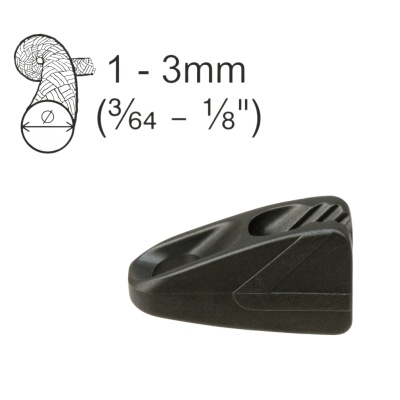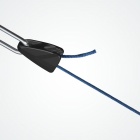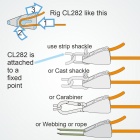Micros tie-down cleat
Description
The Clamcleat® CL282 Micros Tie-down cleat is designed to be attached to fixed point. The rope comes in from the other end, through the fairlead and into the teeth. The free end of the rope is pulled to tension. Used for tie-downs and tensioning control lines on canoes, kayaks and sailing dinghies.
Read more| Code | Weight [g] | In Stock | Price | |
|---|---|---|---|---|
|
CL282
|
0 |
159 pcs i
Next
shipment |
$1.80($1.80 ex.VAT) |
|
The Clamcleat® CL282 Micros Tie-down cleat is designed to be attached to fixed point. The rope comes in from the other end, through the fairlead and into the teeth. The free end of the rope is pulled to tension. Used for tie-downs and tensioning control lines on canoes, kayaks and sailing dinghies. Power of up to 50kgs. Similar to Line-Lok Rope Tensioner Black: 1-2.5 mm.
Which size to choose?
The diameters of the usable ropes listed in the table are extreme. Tensioners work optimally when used on ropes between the minimum and maximum diameter. It is also necessary to take into account the exact diameter of the rope (not rounded size) - the diameters of the Mastrant ropes are here or on a particular item in our online shop.
How long do cleats last?
This really depends on how cleats are used. We often see nylon cleats that are over 10 years old, when they have been used for light loads on control lines. However, tensioning a rope by dragging it back through the teeth will quickly burn out a nylon cleat. This is why alloy cleats were originally developed. Alloy cleats withstand this type of use, as long as the rope is clean. A dirty rope that is full of sand will wear out any fitting. Windsurfers and kitesurfers who have to rig on coral sand beaches certainly know that their equipment has a limited life. Hard anodised cleats have slightly better wear resistance than silver ones. Nylon cleats are completely resistant to salt water corrosion. They are also resistant to many acid and chemicals. Alloy cleats have "excellent” corrosion resistance. Hard anodised cleats have slightly better corrosion resistance than silver ones.





